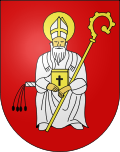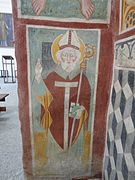Cademario
| Cademario | |
|---|---|
| State : |
|
| Canton : |
|
| District : | Lugano district |
| Circle : | Agno district |
| BFS no. : | 5161 |
| Postal code : | 6936 |
| Coordinates : | 712 622 / 97646 |
| Height : | 792 m above sea level M. |
| Height range : | 353–974 m above sea level M. |
| Area : | 3.96 km² |
| Residents: | 775 (December 31, 2018) |
| Population density : | 196 inhabitants per km² |
| Website: | www.cademario.ch |
|
Cademario, the Kurhaus on the top left |
|
| Location of the municipality | |
Cademario is a municipality in the Malcantone region in the Agno district in the Lugano district in the canton of Ticino in Switzerland . The name should be derived from Casa de Mario ( Mario's house).
geography
Cademario is located in the upper Malcantone on the western side of the Vedeggio valley . The highest point is at an altitude of 974 meters at Alpe Agra , the lowest point at 374 meters above Bioggio . Around 16 percent of the land area of Cademario is used for agriculture, almost 80 percent is forested. Due to the sunny and sheltered location, the climate is mild, almost Mediterranean.
history
The area around Cademario was already settled during the Iron Age, as evidenced by a cemetery with cremation burials that was excavated in La Forcora (between Cademario and Aranno) between 1939 and 1940. The village was first mentioned in 1163 as Cademerio and in 1335 as Cadelmario Superiore to distinguish it from Cadelmario Inferiore, today's Bosco Luganese , which separated in 1783. The hamlets of Renera and Bogno belong to Cademario. The village of Bioggio in the valley used to be part of the municipality. Around 1000 the Bishop of Como owned goods and rights in Cademario, which later passed at least partially to the Benedictine Abbey of Sant'Abbondio in Como, whose abbot owned a house in Cademario. had to provide 44 soldiers to the Duke of Milan in the first half of the 15th century .
Local civil parish
Former local citizen families are Braga, De Mozo, De Tessia, Fontana (di Cademario), Gilardi, Indemini, Idempne, Lepori (De Leporibus), Magnoli, Orlando, Pomina, Rosso (del Rosso), Rubeo (del Rubeo), Rossi, Sarbore (del Sarbore) and Speranza.
Living local citizen families
- Alberti (De Alberti), Bernardazzi, Carletta, De Vittori (Devittori, Vittori), Fontana (di Bosco Luganese), Jermini, Monti (Monte, Montinus), Moriggia, Panzera, Pianca (Planca, Piancha, Pyancha), Righetti, Vanetta .
population
| Population development | ||||||||||||||
|---|---|---|---|---|---|---|---|---|---|---|---|---|---|---|
| year | 1599 | 1696 | 1801 | 1900 | 1950 | 1970 | 1980 | 1990 | 2000 | 2005 | 2010 | 2014 | 2016 | 2017 |
| Residents | 500 | 370 | 331 | 347 | 422 | 435 | 451 | 474 | 610 | 674 | 718 | 745 | 791 | 796 |
economy
For centuries, the slopes from the village down to Bioggio have been cultivated with vines. In 1990 the vineyards covered an area of 600 ares and produced 22,000 vines. In recent decades, some vineyards have had to give way to the numerous second homes that now stretch far down the slope. Only the name remains of the once cultivated Alpe Agra in the forest above the village, all buildings have disappeared. Cademario was one of the first Luganese villages to be discovered for tourism in the 1910s because of the unique panoramic position protected from the north wind, the mild climate and the all-day sunshine.
Attractions
- Old parish church of St. Ambrose (Sant'Ambrogio vecchio) and cemetery: The Romanesque church dates from the 12th century and was probably built on the foundations of an older church. In the 14th century it was supplemented with a side aisle and decorated with frescoes , remains of which have been preserved. In the 17th century the church was expanded again. Its axis was turned to the north, a rectangular choir was added and the floor level was raised. The church was last renovated in 2004. It is listed in the Swiss cultural property inventory and cemetery
- Frescoes in Sant'Ambrogio vecchio
- Parish Church of Sant'Ambrogio (formerly Santa Maria del Popolo) It was built in the early 17th century, later enlarged and re-consecrated in 1833.
- Kurhaus Cademario, Architects: Arnoldo Ziegler, Achille Galli. In 1914, the naturopathic doctor Adolf Keller built the Kurhaus Cademario, at an altitude of 850 meters in the middle of a 10,000 m² park high above the village, which at the time was the highest in the canton. Keller relied on the methods of the natural healer Arnold Rikli (1823–1906). Meat and alcohol were forbidden, but there was vegetarian diet food, herbal tea and sunbathing, fresh air gymnastics strictly separated according to sex and barefoot walks at all times of the year and day as well as baths in the unheated outdoor swimming pool, the first in the canton. The Kurhaus includes a park created by Keller with the most important cactus collection in the Canton of Ticino. In 1917 the Kurhaus was combined with the Kurhaus Monte Bré to form the Kuranstalten AG. Keller was the medical director, Max Pfenning was the economic director. In 1924/25 the Kurhaus was expanded with the addition of the west wing. Keller ran the Kurhaus until his death in 1969. The Keller family ran the house for two more generations. A modern, publicly accessible wellness center was built in the 1980s and 1990s. In 2006 it came into the possession of the Tessal SA hotel group. It was converted into a luxurious wellness hotel over a period of four years for a good 30 million francs. The building shell is still a listed building. The lowest part of the terraced garden with flowers and herbs above the Kurhaus von Keller had to give way to lawns. The viewing terrace in the uppermost part and the greenhouse with the cellar's cactus collection have been preserved. new buildings (1924/1925), architect: Otto Heidemann
- The necropolis in the Forcora district is listed in the Swiss inventory of cultural property
- Alpe Agra nature reserve , registered in the federal inventory of amphibian spawning areas of national importance.
- Schalenstein in the Quadrella district (800 m above sea level)
Sports
The Associazione Sportiva Cademario. (Abbr. AS Cademario, Cademario or in the dialect "Canvée") is a football club founded in 1925. He currently plays (2017) in the 3rd league of the Federazione Ticinese di Calcio Cademario was five times champion of the former Malcantonesian league in the seasons 1944/45, 1945/46, 1953/54 and 1954/55 and 1958/59.
Personalities
literature
- Franco Binda: Il mistero delle incisioni , Armando Dadò editore, Locarno 2013, ISBN 978-88-8281-353-6 .
- Virgilio Chiesa : Cademario. In: Lineamenti storici del Malcantone. Tipografia Gaggini-Bizzozero, Lugano 1961.
- Bernardino Croci Maspoli: Cademario. In: Historical Lexicon of Switzerland . November 17, 2004 , accessed December 30, 2019 .
- Paolo Norsa: L'antico Comune di Cademario. Tipografia Rezzonico-Pedrini, Lugano 1945.
- Simona Martinoli u. a .: Guida d'arte della Svizzera italiana. Ed. Society for Swiss Art History GSK. Edizioni Casagrande, Bellinzona 2007, ISBN 978-88-7713-482-0 , pp. 395-397.
- Fabrizio Panzera and others: I cento anni del Kurhaus di Cademario. in “Arte & Storia”, Volume 14, Number 63, Edizioni Ticino Management, Ed .: Giorgio Mollisi, Lugano November 2014.
- Giovanni Maria Staffieri : Cademario. In: Malcantone. Testimonianze culturali nei comuni malcantonesi. Lugano-Agno 1985, pp. 89, 90-93, 95.
- Celestino Trezzini : Cademario In: Historisch-Biographisches Lexikon der Schweiz , Volume 2, Brusino - Caux , Attinger, Neuenburg 1924, pp. 468-469 ( digitized version ), (accessed on July 11, 2017).
Web links
- Cademario on the ETHorama platform
- Website of the municipality of Cademario
- Data from the municipality of Cademario
- Office for Statistics of the Canton of Ticino: Cademario (Italian)
- Cademario: inventory of cultural assets of the Canton of Ticino
- Cademario on elexikon.ch
- April 15, 1494 Sale, Carta vendicionis (Italian) at ti.ch/archivio-pergamene (accessed on January 22, 2017).
Individual evidence
- ↑ Permanent and non-permanent resident population by year, canton, district, municipality, population type and gender (permanent resident population). In: bfs. admin.ch . Federal Statistical Office (FSO), August 31, 2019, accessed on December 22, 2019 .
- ↑ Cademario on biblio.unibe.ch/digibern/hist_bibliog_lexikon_schweiz (accessed on July 11, 2017).
- ^ Bernardino Croci Maspoli: Cademario. In: Historical Lexicon of Switzerland . February 15, 2005 .
- ↑ a b c d e Simona Martinoli and others: Guida d'arte della Svizzera italiana. Edited by the Society for Swiss Art History GSK, Edizioni Casagrande, Bellinzona 2007, ISBN 978-88-7713-482-0 , pp. 395–397.
- ^ Old parish church of St. Ambrose
- ↑ Parish Church of Sant'Ambrogio (former Santa Maria del Popolo)
- ^ Kurhaus Cademario
- ^ Fabrizio Panzera et al. a .: I cento anni del Kurhaus di Cademario. Una tradizione che continua Edizioni Ticino Management, anno 14, numero 63, Lugano November 2014
- ↑ Necropolis at Forcora
- ^ Decreto di protezione dello Stagno Agra
- ^ Franco Binda: Il mistero delle incisioni , Armando Dadò editore, Locarno 2013, pp. 48–49.
- ^ Associazione Sportiva Cademario (Italian) on ascademario.ch
- ^ Federazione ticinese di calcio - Federazione ticinese di calcio. Retrieved January 20, 2017 (Italian).









